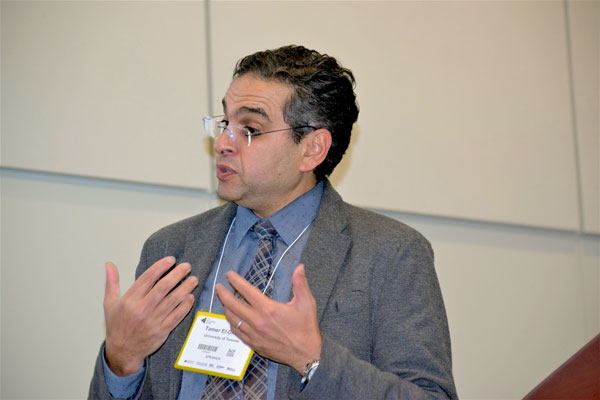Canada’s construction sector is seriously lagging in exploiting social media analytics and mining other data sources to improve projects, a Buildings Show workshop audience was told recently.
Beyond a few standout firms, the sector is complacent and falling behind such data analytics powerhouses as China and Germany, and even the United States is ahead of Canadian constructors, said Tamer El-Diraby, an associate professor in the Department of Civil and Mineral Engineering at the University of Toronto and the director of the Centre for Civil Informatics.
“It is the future and the Canadian construction industry needs to be going into the future because it is a fundamental change in thinking,” El-Diraby said in an interview after his Nov. 28 presentation. “It is not just a tool, it is not a computer program, or a website, it requires a change in behaviour, in the mentality in the organization. If we are not doing this we will be left behind.”
There are very few stages in the planning and execution of projects where the knowledge gained from data analytics can’t enhance the process, said the professor.
An expanded knowledge base enables better decisions on multi-modal transportation options, improved anticipation of consumer reaction to green-shift policies, better locations for transit stations, more thorough equity considerations as part of social needs analysis, better tracking of public opinion on dedicated streetcar routes — even improved maintenance plans for newly paved roadways.
“There is a ton of data around us that you can collect,” said El-Diraby. “The city is collecting data about potholes and traffic, they have tons of data in this regard. Environment Canada has tons of data about weather and changes. Revenue Canada has information about taxes which can tell you about the income of the community, and if you want to engage equity in your decision-making you can take out of this what you want.”
The repercussions of ill-informed decisions can be costly. El-Diraby gave an example of a project where social media was weighted too heavily.
After engineers planning the Eglinton Crosstown determined a Leslie Street/Sunnybrook Park station would be under-used and would not lead to intensification because there were already lots of residential towers in the area, local citizens banded together on Twitter to create a storm and, given an election was coming, Toronto council voted to keep the station, at a cost of $80 million.
“Social media is never a replacement for community meetings, traditional marketing and customer analysis,” said El-Diraby. “It is complementary only.”

An analytics team tracked the Eglinton Crosstown process extensively to learn how communities were grouping together or diverging on strategy. A total of 33,135 distinct words were identified on Twitter relating to the process and analyzed. The project team had special insights when, for example, in January 2013, Toronto councillors proposed proceeding with the Eglinton section but delaying the Scarborough link.
“The beauty of the social, it’s called unstructured data because it comes in a text, but boy does it have a lot of knowledge in it,” said El-Diraby.
In the race of the knowledge haves and have-nots, he said, the haves are pulling away and using a whole new stakeholder engagement vocabulary that includes such terms as “social semantic analysis” to decide where bike-sharing depots should be placed in New York City, the “social BIM” of projects to create an “as built” record, “blockmodelling” that compares networks of information and “product ontology” that enables constructors to embed project data into existing web pages and databases.
El-Diraby said if the takeover of Aecon by the construction arm of the China Communications Construction Co. had gone through, the Canadian firm would have had a window into extensive new data usage practices.
“When you look at the China construction company, they are investing tons of money in intelligence and security, they have no limits,” he said. “When you look at the Germans, they are way ahead of us in this regard. So the Canadian construction industry should be aware of that.”
But Canada seems to be content with its current modest strengths and profits, El-Diraby said, with only a handful of large firms taking the leap forward into serious data analytics.
“Thankfully a couple of actors are doing well,” he said, referring specifically to EllisDon, PCL and IBI. “So I hope this will send the right message.”
Meanwhile, Canada’s public agencies are “way behind,” El-Diraby charged.
“The Ministry of Transportation, the cities, their perspective on decision-making is more complicated than a contractor who is calculating how much is the cost,” he said. “Their perspective must include responses to the community, responses to economic development, protection of the environment, being equitable, being protective of privacy.”



Recent Comments
comments for this post are closed